Abstract
Design Retrospective cohort study.
Cohort selection Records of 2,922 patients, who attended a reference centre between 1998 and 2019 with primary dental trauma and who had radiographs and photographs, were screened to identify primary dental avulsion injuries that were followed-up until complete eruption of the permanent successors. 240 records were eligible and 194 fulfilled the inclusion criteria.
Data analysis Exploratory descriptive analysis was carried out to map the occurrence and type of sequelae to the permanent tooth following primary avulsion, comparing this to the control group of permanent anterior teeth from the same children where the predecessor teeth had not suffered any type of dental trauma. Exploratory descriptive analysis was also used to link the age the primary avulsion occurred to the type of sequelae to permanent dentition. Multilevel Poisson regression analysis was performed and relative risk values and respective 95% confidence intervals were calculated to evaluate the association between avulsion and occurrence of sequelae. Confounders were included in the model to calculate their effect.
Results Of the 194 patients included, there were 266 avulsed primary teeth and 115 of the permanent successors presenting with sequelae (43.2%), compared to 15.4% in the control group. Demarcated opacities were most common in both groups. Primary tooth avulsions occurring in children under two years old had a higher risk of sequelae to the permanent successor. There was also a higher risk of successor sequelae with avulsions of the lower arch compared to the upper and when three or more teeth were affected by the trauma compared to a single tooth. Avulsions in children over three years old had a lower risk of hypoplasia and those over four years old had a low risk of opacities to the successor.
Conclusions Following avulsions of primary teeth, there is a higher risk of sequelae to the permanent successor in children younger than two years, where the lower jaw is involved and when multiple teeth are involved.
This is a preview of subscription content, access via your institution
Access options
Subscribe to this journal
Receive 4 print issues and online access
$259.00 per year
only $64.75 per issue
Buy this article
- Purchase on Springer Link
- Instant access to full article PDF
Prices may be subject to local taxes which are calculated during checkout
Similar content being viewed by others
Change history
25 March 2022
A Correction to this paper has been published: https://doi.org/10.1038/s41432-022-0234-2
References
Petti S, Glendor U, Andersson L. World traumatic dental injury prevalence and incidence, a meta analysis - One billion living people have had traumatic dental injuries. Dent Traumatol 2018; 34: 71-86.
Ravn J J. Sequelae of acute mechanical traumata in the primary dentition. A clinical study. ASDC J Dent Child 1968; 35: 281-289.
Day P F, Flores M T, O'Connell A C et al. International Association of Dental Traumatology guidelines for the management of traumatic dental injuries: 3. Injuries in the primary dentition. Dent Traumatol 2020; 36: 343-359.
Talari K, Goyal M. Retrospective studies - utility and caveats. J R Coll Physicians Edinb 2020; 50: 398-402.
Author information
Authors and Affiliations
Rights and permissions
About this article
Cite this article
Osborne, R. What is the impact of primary dental avulsion injuries on the permanent dentition?. Evid Based Dent 22, 136–137 (2021). https://doi.org/10.1038/s41432-021-0228-5
Received:
Accepted:
Published:
Issue Date:
DOI: https://doi.org/10.1038/s41432-021-0228-5



